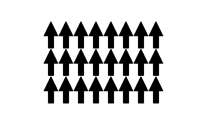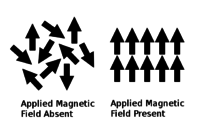
Back درجة حرارة كوري Arabic Küri nöqtəsi Azerbaijani Кропка Кюры BE-X-OLD Температура на Кюри Bulgarian ক্যুরি তাপমাত্রা Bengali/Bangla Curiejeva tačka BS Temperatura de Curie Catalan Curieova teplota Czech Curietemperaturen Danish Curie-Temperatur German
In physics and materials science, the Curie temperature (TC), or Curie point, is the temperature above which certain materials lose their permanent magnetic properties, which can (in most cases) be replaced by induced magnetism. The Curie temperature is named after Pierre Curie, who showed that magnetism is lost at a critical temperature.[1]
The force of magnetism is determined by the magnetic moment, a dipole moment within an atom that originates from the angular momentum and spin of electrons. Materials have different structures of intrinsic magnetic moments that depend on temperature; the Curie temperature is the critical point at which a material's intrinsic magnetic moments change direction.
Permanent magnetism is caused by the alignment of magnetic moments, and induced magnetism is created when disordered magnetic moments are forced to align in an applied magnetic field. For example, the ordered magnetic moments (ferromagnetic, Figure 1) change and become disordered (paramagnetic, Figure 2) at the Curie temperature. Higher temperatures make magnets weaker, as spontaneous magnetism only occurs below the Curie temperature. Magnetic susceptibility above the Curie temperature can be calculated from the Curie–Weiss law, which is derived from Curie's law.
In analogy to ferromagnetic and paramagnetic materials, the Curie temperature can also be used to describe the phase transition between ferroelectricity and paraelectricity. In this context, the order parameter is the electric polarization that goes from a finite value to zero when the temperature is increased above the Curie temperature.
| Material | Curie temperature in | ||
|---|---|---|---|
| K | °C | °F | |
| Iron (Fe) | 1043–1664 | 770 | 1418 |
| Cobalt (Co) | 1400 | 1130 | 2060 |
| Nickel (Ni) | 627 | 354 | 669 |
| Gadolinium (Gd) | 292 | 19 | 66 |
| Dysprosium (Dy) | 88 | −185.2 | −301.3 |
| Manganese bismuthide (MnBi) | 630 | 357 | 674 |
| Manganese antimonide (MnSb) | 587 | 314 | 597 |
| Chromium(IV) oxide (CrO2) | 386 | 113 | 235 |
| Manganese arsenide (MnAs) | 318 | 45 | 113 |
| Europium oxide (EuO) | 69 | −204.2 | −335.5 |
| Iron(III) oxide (Fe2O3) | 948 | 675 | 1247 |
| Iron(II,III) oxide (FeOFe2O3) | 858 | 585 | 1085 |
| NiO–Fe2O3 | 858 | 585 | 1085 |
| CuO–Fe2O3 | 728 | 455 | 851 |
| MgO–Fe2O3 | 713 | 440 | 824 |
| MnO–Fe2O3 | 573 | 300 | 572 |
| Yttrium iron garnet (Y3Fe5O12) | 560 | 287 | 548 |
| Neodymium magnets | 583–673 | 310–400 | 590–752 |
| Alnico | 973–1133 | 700–860 | 1292–1580 |
| Samarium–cobalt magnets | 993–1073 | 720–800 | 1328–1472 |
| Strontium ferrite | 723 | 450 | 842 |
- ^ Pierre Curie – Biography
- ^ Buschow 2001, p5021, table 1
- ^ Jullien & Guinier 1989, p. 155
- ^ Kittel 1986

